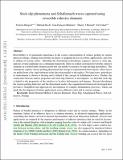Stick–slip phenomena and Schallamach waves captured using reversible cohesive elements
Author(s)
Ringoot, Evelyne; Roch, Thibault; Molinari, Jean-François; Massart, Thierry J; Cohen, Tal
DownloadAccepted version (8.424Mb)
Publisher with Creative Commons License
Publisher with Creative Commons License
Creative Commons Attribution
Terms of use
Metadata
Show full item recordAbstract
Reversibility is of paramount importance in the correct representation of surface peeling in various physical settings, ranging from motility in nature, to gripping devices in robotic applications, and even to sliding of tectonic plates. Modeling the detachment–reattachment sequence, known as stick–slip, imposes several challenges in a continuum framework. Here we exploit customized reversible cohesive elements in a hybrid finite element model that can handle occurrence of snap-through instabilities. The simulations capture various peeling phenomena that emerge in experimental observations, where layers are pulled from a flat, rigid substrate in the direction parallel to the surface. For long layers, periodicity in reattachment is shown to develop and is linked to the concept of Schallamach waves. Further, the connection between surface properties and stick–slip behavior is investigated: we find that stick–slip is linked to the propensity of the interface to localize deformation and damage. Beyond elucidating the various peeling behaviors and the detachment modes, the computational framework developed here provides a straightforward approach for investigation of complex delamination processes, which can guide the development of future applications across different scales and in various settings.
Date issued
2021-10Department
Massachusetts Institute of Technology. Department of Civil and Environmental Engineering; Massachusetts Institute of Technology. Department of Mechanical EngineeringJournal
Journal of the Mechanics and Physics of Solids
Publisher
Elsevier BV
Citation
Evelyne Ringoot, Thibault Roch, Jean-François Molinari, Thierry J. Massart, Tal Cohen, Stick–slip phenomena and Schallamach waves captured using reversible cohesive elements, Journal of the Mechanics and Physics of Solids, Volume 155, 2021
Version: Author's final manuscript
ISSN
0022-5096